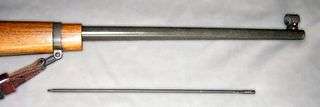Cleaning rod
A cleaning rod is a firearm maintenance tool that can be used to clean the inside (bore) of a gun's barrel, and is made in different sizes for use on different barrel lengths, calibers and gauges. It is a sturdy, long, thin, straight rod typically made of metal, rigid plastic or carbon fiber, and usually has a handle at one end for gripping and threadings at the other end for attaching cleaning accessories. It is used to push brushes, mops and cotton patches through the bore to deliver solvents and scrub away foulings, or to physically remove any obstructing objects such as a squib load.

Commonly, a breech-end extension tube, known as a bore guide or rod guide, is also used in conjunction with the cleaning rod to prevent cleaning solvent from spilling out into the receiver, and to keep the rod supported and centered inside the bore in order to minimize potential damage to riflings. Similarly, a muzzle guide or muzzle guard might be used if the cleaning rod is to be inserted from the muzzle end of the firearm in order to protect the crown of the muzzle from mechanical damage.
A cleaning cord, also known as a "bore snake", is an alternative gun care tool to a cleaning rod. A bore snake is a flexible fabric cord with a tapered thin end that has a weight attached to it, in order to help the initial feeding of the cord through the breech end of the barrel. When the thin end has been fed throughout the other end, the rest of the cord is then dragged towards the muzzle, scrubbing the bore along the way. A bore snake often has one or more integrated brushes to help clear away more stubborn contaminants, and may also be used to apply lubricants.
Thread sizes
The screw thread sizes and "genders" used for attaching brushes to the rods vary between different calibers and manufacturers. Some of the most common threads and genders for rods/cords are listed below.[1] Corresponding brushes and other accessories will have the opposite gender.
Rods for .17 to .204 caliber (4.4 to 5.2 mm)
- #5-40 UNC female
Rods for .22 to .50 caliber (5.56 to 12.7 mm)
Rods for shotguns (including 12, 20, 28 and .410 gauge)
- #12-28 UNF male
- 5/16-27 UNC female
See also
References
.jpg)